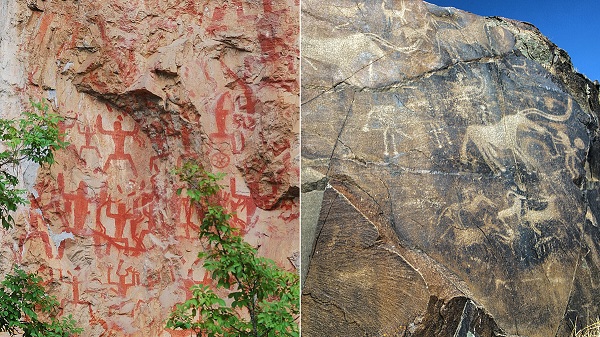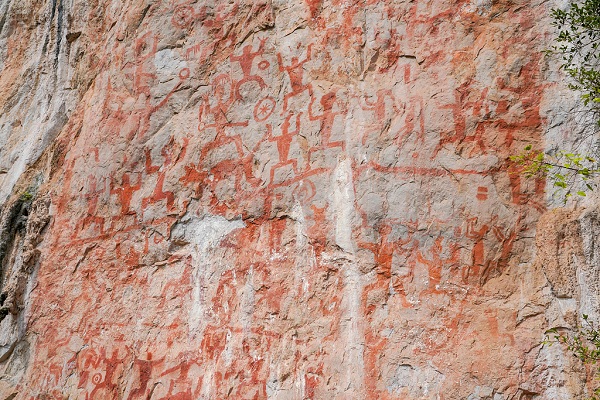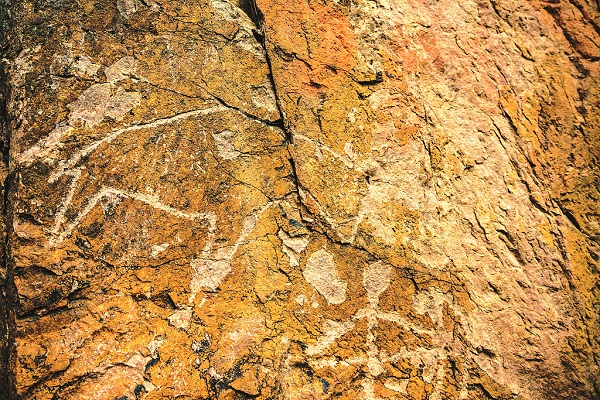Rock paintings tell ancient stories of China, Kazakhstan

The Zuojiang Huashan Rock Art Cultural Landscape in Guangxi, China (left) and the Petroglyphs of the Archaeological Landscape of Tanbaly, Kazakhstan.[Photo/CGTN]
On the steep cliffs of the border regions of South China's Guangxi Zhuang autonomous region, the Luoyue people, ancestors of the Zhuang ethnic group, left their primitive painting works on the rock thousands of years ago. Around 3,000 kilometers away in Tanbaly, Kazakhstan, a large number of petroglyphs dot ancient residences and tombs, showing how people lived, worked, and organized religious customs many centuries ago.
These two historical sites, both included in UNESCO's World Heritage List, are precious relics left by the two populations' respective ancestors. Illustrating two very different civilizations, the rock art sites in China and Kazakhstan bear many differences, yet they also bear uncanny resemblances in certain aspects. A closer inspection of these two heritage sites shows how far-removed civilizations can hint at similar pasts.

A scene from Zuojiang Huashan Rock Art Cultural Landscape shows a ritual practiced by the Luoyue people in ancient times.[Photo/CGTN]
Zuojiang Huashan Rock Art Cultural Landscape
Located in a surrounding landscape of karst rocks, rivers and raised plains, the Zuojiang Huashan Rock Art area dates from around 500 BC to 200 AD. It serves as a testament to the Luoyue people's lifestyle, religion, culture and art from the Warring States period (475-221 BC) to the Eastern Han Dynasty (25-220).
The rock art landscape is comprised of 38 sites in total. They were painted on the cliffs along the Zuojiang River and its tributary, the Mingjiang River, stretching more than 100 kilometers.
Some 4,050 painted images have been discovered there to date. Most of them are scattered at least 15 meters above the river's surface, with the highest one painted 130 meters above the water.
Humans, animals and tools make up almost all of the images. The most typical scene features a large male who is shown half crouching with his hands raised, weapons strung around his waist, and many smaller figures surrounding him in the same pose. It is widely believed by archaeologists and historians that such scenes reflect the sacrificial activity of the Luoyue people.
The red pigment the Luoyue people used to paint these images is hematite powder mixed with diluted animal fat. This highly durable cocktail explains why the color remains visible despite thousands of years of battling the elements. However, experts still struggle to explain how these ancient Chinese people were able to paint at such altitudes on cliffs. Experts have suggested numerous theories as to how they did it, but none have been able to successfully implement it despite the use of the latest technology.

An image from the Petroglyphs of the Archaeological Landscape of Tanbaly depicts a bull and a human figure.[Photo/CGTN]
Petroglyphs of the Archaeological Landscape of Tanbaly
Located among the vast and arid mountains of the Tanbaly canyon is a remarkable concentration of about 5,000 petroglyphs dating from 1500 BC to 1900 AD, most of which belong to the Bronze Age.
The images are scattered around 48 complexes, mostly human settlements and burial grounds. The five most important display about 3,000 images, such as solar deities, zoomorphic beings dressed in fur, religious rituals, and a wide range of animals.
The images were engraved on hills using stone and metal tools, so that a motif could be depicted on the brighter layer under the dark patina. This technique was used from the Bronze Age (2000-700 BC) until the Turkic medieval period (500-1300 AD).
The dense and coherent group of petroglyphs, with sacred images, altars and rituals, together with their associated settlements and burial sites, provide a substantial testimony to animal husbandry at the time as well as the social organization and rituals of pastoral peoples of the central Asian steppes from the Bronze Age to the present day, giving this UNESCO-recognized site an outstanding historical value.
Rock art originated as far back as 40,000 years ago, much earlier than written records. Though it has been found all over the world, its motifs and styles are surprisingly similar. The paintings discovered on the cliffs in Guangxi and the carvings on the rocks in Tanbaly, share a long, common creation period, and serve as a crucial testimony to the lives and beliefs of the people who lived there in ancient times.
